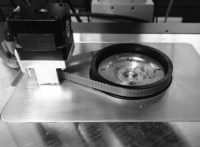Mechanosensation in many organs (e.g. lungs, heart, gut) is mediated by biosensors (like mechanosensitive ion channels), which convert mechanical stimuli into electrical and/or biochemical signals. To study those pathways, technical devices are needed that apply strain profiles to cells, and ideally allow simultaneous live-cell microscopy analysis. Strain profiles in organs can be complex and multiaxial, e.g. in hollow organs. Most devices in mechanobiology apply longitudinal uniaxial stretch to adhered cells using elastomeric membranes to study mechanical biosensors. Recent approaches in biomedical engineering have employed intelligent systems to apply biaxial or multiaxial stretch to cells. Here, we present an isotropic cell stretch system (IsoStretcher) that overcomes some previous limitations. Our system uses a rotational swivel mechanism that translates into a radial displacement of hooks attached to small circular silicone membranes. Isotropicity and focus stability are demonstrated with fluorescent beads, and transmission efficiency of elastomer membrane stretch to cellular area change in HeLa/HEK cells. Applying our system to lamin-A overexpressing fibrosarcoma cells, we found a markedly reduced stretch of cell area, indicative of a stiffer cytoskeleton. We also investigated stretch-activated Ca2+ entry into atrial HL-1 myocytes. 10% isotropic stretch induced robust oscillating increases in intracellular Fluo-4 Ca2+ fluorescence. Store-operated Ca2+ entry was not detected in these cells. The Isostretcher provides a useful versatile tool for mechanobiology.
Read the full publication in Biosensors and Bioelectronics.


